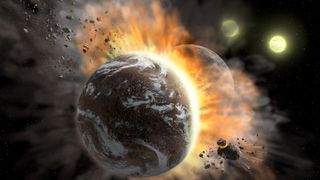Simulations show that collisions between moons and planets may be a regular danger for possible extraterrestrial life.

Alien planets may collide with their own moons regularly, a new simulation suggests. (Image credit: NASA/SOFIA/Lynette Cook)
The moon crashing into Earth may sound like an unrealistic doomsday scenario or the stuff of sci-fi disasters. But for some planets in other star systems, such catastrophic collisions may be common.
New research published in the journal Monthly Notices of the Royal Astronomical Society(opens in new tab) uses computer simulations to show that collisions between exoplanets and their moons (called exomoons) may actually be a regular occurrence, which could be disastrous for any budding alien life on those planets.
While astronomers have yet to make a confident detection of an exomoon, scientists expect them to be plentiful in the universe.
“We know of lots of moons in our own solar system, so naturally we’d expect to see moons in exoplanet systems,” Jonathan Brande(opens in new tab), a University of Kansas astrophysicist who was not associated with the new study, told Live Science in an email. Therefore, theorists such as Brad Hansen(opens in new tab), an astronomer at the University of California, Los Angeles and author of the new study, are interested in exploring how alien moons and exoplanets may interact, and how these interactions affect the potential for life in distant star systems.
Runaway moons
Gravity rules the interactions between a planet and its moons, manifesting as tides and other effects, like the slow recession of our own moon. Every year, Earth’s moon creeps a little over an inch farther away from our planet, its orbit growing larger each year. At the same time, Earth spins a little more slowly every year. These two effects are directly related: Earth is giving some of the angular momentum from its spin to the moon’s orbit.
If this trade-off were to continue long enough, the moon could eventually become unbound from Earth. Thankfully for us, this process would take so long that the sun would explode long before the moon could fully escape. But around some exoplanets, particularly those much closer to their stars than Earth is to the sun, this situation could evolve much faster, with planets and their “unstable” moons colliding within the first billion years of their formation, according to Hansen’s calculations. (For comparison, Earth and its moon are about 4.5 billion years old).
In his simulations, moons that wandered away from their host planets often returned with a bang, smashing into the planet and creating huge dust clouds. These dust clouds glowed in the infrared, as they were illuminated and warmed by the star’s light. But they lasted only about 10,000 years before fading away — a cosmic blink of an eye.
Observations from NASA’s Wide-field Infrared Survey Explorer space telescope suggest that every star will undergo one such event at some point in its lifetime, Hansen said. It’s plausible that these dust emissions represent the collisions between planets and their moons, he added.
Because these dust clouds are so short-lived, however, astronomers have observed only about a dozen of them. Plus, some astronomers are still not convinced these dust clouds are from exomoons, instead suggesting that they may result from collisions between two planets. Either way, more observations are needed to figure out the role of exomoons in an exoplanet’s evolution and to determine if these collisions may affect alien life.
“Moons are often considered helpful,” Hansen said. They’re thought to help stabilize the tilt of a planet’s axis, making for gentler seasons that are more conducive to life. However, a collision like those in Hansen’s simulations would certainly outweigh this benefit by destroying any chance of life in a fiery explosion.
“Every couple of weeks, it seems like there’s some CGI video(opens in new tab) that goes viral showing the Earth being destroyed by some massive cosmic impactor,” Brande added. “If you were unlucky enough to live in the primordial goo on some young rocky exoplanet, you might find out what you’d actually do in that situation! Not the best result in the search for extraterrestrial life, but worth knowing all the same.”









